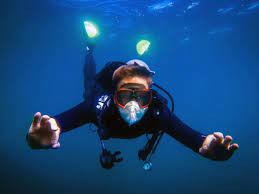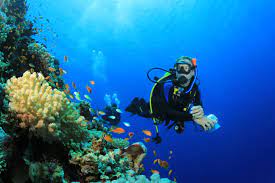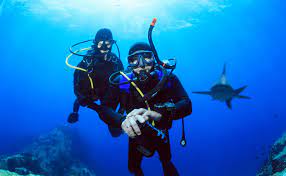Mini scuba tanks (e.g., 1-3L) offer 5-15 minutes of air vs. standard tanks (10-15L) providing 30-60 minutes, with mini tanks weighing 2-5 lbs (portable) vs. standard 25-35 lbs. Mini tanks suit shallow dives (<10m) with low air capacity, while standard tanks handle deeper/longer dives (30m+). Mini tanks lack pressure gauges and use simpler valves, whereas standard tanks feature high-pressure valves (200-300 bar) and advanced regulators. Cost: minis 150, standards 500. Choose based on dive needs.
Size & Weight Comparison
Mini tanks, typically 1-3 liters (L) in volume, weigh between 2-5 pounds (0.9-2.3 kg), making them extremely portable—ideal for snorkelers, freedivers, or emergency backup air. In contrast, standard scuba tanks range from 10-15L, weighing 25-35 pounds (11-16 kg) when empty and even more when filled. The difference is stark: a mini tank is about 10-20% the size of a standard one, which directly impacts mobility, storage, and ease of transport.
Standard tanks are built for longer, deeper dives, so their larger size is necessary to hold more air at higher pressures (usually 200-300 bar). Mini tanks, however, operate at lower pressures (150-200 bar) and are often made from aluminum or lightweight steel to keep weight down. For example, a 2L mini tank might be 18 inches (45 cm) tall and 5 inches (13 cm) in diameter, while a 12L standard tank could be 24 inches (61 cm) tall and 7.5 inches (19 cm) wide. This makes standard tanks bulkier and harder to carry without a proper harness or backpack.
If you’re diving from a boat, the size difference also affects how many tanks you can bring—where a boat might store 20 mini tanks, it may only hold 8-10 standard tanks in the same space.
Key Takeaways:
-
Mini tanks: 1-3L, 2-5 lbs, compact, best for short dives or backup air.
-
Standard tanks: 10-15L, 25-35 lbs, bulky, designed for extended diving.
-
Portability: Mini tanks win for travel; standard tanks need extra handling.
-
Storage: Mini tanks take up 70-80% less space than standard tanks.
But if you need longer bottom time and deeper dives, the size and weight trade-off of a standard tank is unavoidable. The right pick depends on how you dive, where you go, and how much gear you’re willing to carry.
Air Capacity & Dive Time
Mini tanks, usually 1-3 liters (L) in capacity, provide just 5-15 minutes of breathing time for an average diver at shallow depths (3-10 meters). In comparison, standard tanks (10-15L) deliver 30-60 minutes of air, with some high-capacity models extending beyond 90 minutes for slow, relaxed diving. The gap is massive—a standard tank holds 5-10x more air than a mini, making it the only viable option for serious divers.
An average diver breathes about 15-20 liters per minute (L/min) at the surface, but this doubles or triples under stress or at depth due to increased pressure. A 3L mini tank filled to 200 bar contains 600 liters of compressed air, which sounds like a lot—until you realize a diver at 10 meters (2 atm pressure) will burn through it in 10-12 minutes if breathing normally. Meanwhile, a 12L standard tank at 200 bar holds 2400 liters, lasting 40-50 minutes at the same depth.
Dive Time Comparison (Average Consumption: 20 L/min at Surface)
|
Tank Type |
Volume (L) |
Pressure (bar) |
Total Air (L) |
Dive Time (Surface) |
Dive Time (10m) |
|---|---|---|---|---|---|
|
Mini |
3 |
200 |
600 |
30 min |
10 min |
|
Standard |
12 |
200 |
2400 |
120 min |
40 min |
At 20 meters (3 atm), a mini tank’s 10-minute runtime drops to just 5-7 minutes, while a standard tank’s 40-minute dive shrinks to 20-25 minutes. This is why mini tanks are only practical for quick ascents, snorkeling support, or emergency backup—not real scuba diving.
Most mini tanks max out at 200 bar, while standard tanks often handle 230-300 bar, allowing more air in the same physical space. A 15L tank at 300 bar stores 4500 liters, nearly 8x a mini tank’s capacity. However, filling mini tanks beyond 200 bar is risky—their thinner walls aren’t built for extreme pressures.
Who should use which?
-
Mini tanks: Snorkelers, freedivers (safety backup), shallow reef explorers (5m max).
-
Standard tanks: Recreational divers, deep divers (20m+), long underwater photographers.
Mini tanks require constant refills—after just two 10-minute dives, you’ve emptied a 3L tank, whereas a standard tank could last 3-4 dives before needing air.

Depth & Usage Limits
Mini tanks, with their smaller air reserves and lower pressure ratings (150-200 bar), are realistically limited to shallow dives of 5-10 meters (16-33 feet). Push beyond that, and you’ll burn through air so fast that the tank becomes useless in minutes. Standard tanks, on the other hand, are designed for depths of 30-40 meters (100-130 feet) and can even support technical dives beyond 50 meters (165 feet) when used with proper gas mixes.
The physics behind this is simple: every 10 meters of depth increases ambient pressure by 1 atmosphere (atm), which means your lungs work harder to draw air, and your tank drains faster. At 10 meters (2 atm), a mini tank’s 10-minute dive time drops to 5-7 minutes—barely enough for a quick look around. At 20 meters (3 atm), that same tank might last 3-4 minutes, making it impractical for anything but emergency ascents. Standard tanks compensate with larger volumes (10-15L) and higher pressure ratings (200-300 bar), so even at 30 meters (4 atm), a diver can still get 20-25 minutes of bottom time before needing to surface.
Real-World Depth Performance
-
Mini tanks (1-3L)
- 5m max (ideal): 10-15 min dive time
- 10m (absolute limit): 5-7 min before air starvation risk
- Beyond 10m: Unsafe—rapid air depletion
-
Standard tanks (10-15L)
- 20m (recreational limit): 30-40 min dive time
- 30m (advanced recreational): 20-25 min
- 40m+ (tech diving): 10-15 min (requires gas planning)
Usage scenarios also differ drastically. Mini tanks excel for:
-
Snorkeling backup (if you need to duck-dive briefly)
-
Freediving safety (emergency air for blackout recovery)
-
Pool training (where depth is controlled)
Standard tanks are mandatory for:
-
Recreational reef diving (12-18m typical)
-
Wreck penetration (18-30m, requiring extended air supply)
-
Deep diving (30m+ with decompression stops)
Who should care about these limits?
-
Casual divers/snorkelers: Mini tanks work fine for surface support.
-
Recreational divers: Standard tanks are the only safe choice below 10m.
-
Tech divers: Standard tanks are just the starting point—double or staged tanks are often needed.
Valve & Regulator Types
Mini tanks typically use simple on/off K-valves with direct-thread regulators, while standard tanks employ complex DIN or yoke systems with first/second stage regulators capable of handling 5-10x more air flow. This isn't just about convenience—it's about surviving at depth where equipment failure isn't an option.
Most use 3/4" NPSM threaded valves with 200 bar maximum working pressure, about 30% lower than standard tank valves. Their regulators are often single-stage, meaning the entire pressure reduction from tank pressure (200 bar) to breathable pressure (10 bar) happens in one step. This works fine for shallow dives, but at depths beyond 10m, breathing resistance increases noticeably because the system can't compensate well for ambient pressure changes. You'll find these on 90% of mini tanks priced under $150.
DIN valves screw directly into the regulator first stage and handle 300 bar pressures, with metal-to-metal seals that won't blow out during deep descents. The regulators are two-stage systems: the first stage reduces tank pressure to 10-12 bar intermediate pressure, then the second stage delivers air at ambient pressure. This dual-stage design means you'll get easy breathing at 40m just like at the surface. Performance specs tell the story:
-
Mini tank regulator flow rate: 600 liters/minute (adequate for 10m diving)
-
Standard regulator flow rate: 1,200+ liters/minute (handles deep, heavy breathing)
Mini tank valves have O-ring seals that degrade faster and can freeze in cold water, while DIN valves use metal-on-metal sealing that lasts for 5,000+ dives. Regulator maintenance intervals reflect this too—mini setups need servicing every 50-100 dives, while standard regulators go 200-300 dives between overhauls.
Real-world implications:
-
Mini tank users occasionally experience freeflows when the single-stage regulator can't handle sudden depth changes
-
Standard tank divers enjoy consistent performance even during rapid ascents/descents
-
Regulator freeze happens 3x more often with mini setups in water below 10°C (50°F)
Who should compromise?
-
Snorkelers doing occasional 5m dives: Mini tank systems are adequate
-
Weekly recreational divers: Need at least an entry-level DIN regulator
-
Cold water/tech divers: Require sealed, environmentally protected regulators
Price & Best Use Cases
Mini tanks start around 200 for a barebones 10L steel tank and can exceed $600 for premium 15L configurations. But price alone doesn't tell the full story. The real cost difference emerges when you factor in accessories, maintenance, and air fills over a typical 5-year ownership period mini tank care steps.
A complete mini tank setup (tank + valve + basic regulator) averages 250, but you're limited to 5-10 minute dives at shallow depths. Standard tank packages start at 5-50-$80) versus mini tanks that often get replaced before testing is due.
Total Cost of Ownership Comparison (5 Years)tank hydrostatic testing
|
Cost Factor |
Mini Tank (3L) |
Standard Tank (12L) |
|---|---|---|
|
Initial Purchase |
$200 |
$500 |
|
Annual Fills (50 dives/yr) |
$1,250 |
$500 |
|
Regulator Service |
$200 |
$300 |
|
Hydrotesting |
$0 (replaced) |
$80 |
|
Total |
$1,650 |
$1,380 |
Best use cases emerge clearly when you match tank capabilities to actual diving needs. Mini tanks shine for:
-
Snorkelers needing emergency backup air diving emergency procedures (1-2 breaths per minute)
-
Freedivers carrying safety air for surface recovery
-
Pool training where instructors need compact air sources
Standard tanks dominate for:
-
Recreational divers doing 40-60 minute reef dives
-
Dive resorts needing reliable daily tank rotations
-
Underwater photographers scuba gear certification requiring stable bottom time
A 3L mini tank provides about 200 breaths diving oxygen cylinders of air —enough for a panicked snorkeler to reach the surface from 10m, but woefully inadequate for exploring a wreck at 18m. Meanwhile, a 12L standard tank delivers 2,400+ breaths, allowing leisurely exploration with ample safety margin.
Dive shops charge 15 per standard tank rental, but rarely offer mini tanks flying with mini tanks because their 5-10 minute runtime creates customer dissatisfaction. When calculated per minute of bottom time, standard tanks actually deliver better value at 0.50 per minute versus mini tanks' 3 per minute when considering fill costs.
Mini tank valves use simple O-rings aluminum tank benefits that degrade after 100-200 fills, while standard tank DIN valves last 1,000+ fills with proper care. Regulator servicing runs 120 annually for standard setups versus 80 for mini systems, but the standard gear lasts 3-5x longer between overhauls.
The smart buy depends entirely on your dive profile:
-
<10 dives/year mini tank safety rules: Mini tank makes financial sense
-
>20 dives/year: Standard tank pays for itself scuba tank lifespan in 2-3 years
-
Professional use: Always standard tanks—reliability is non-negotiable





Dejar un comentario
Todos los comentarios se revisan antes de su publicación.
Este sitio está protegido por hCaptcha y se aplican la Política de privacidad de hCaptcha y los Términos del servicio.